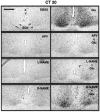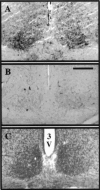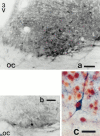Resetting the biological clock: mediation of nocturnal CREB phosphorylation via light, glutamate, and nitric oxide
- PMID: 8987789
- PMCID: PMC6573241
- DOI: 10.1523/JNEUROSCI.17-02-00667.1997
Resetting the biological clock: mediation of nocturnal CREB phosphorylation via light, glutamate, and nitric oxide
Abstract
Synchronization between the environmental lighting cycle and the biological clock in the suprachiasmatic nucleus (SCN) is correlated with phosphorylation of the Ca2+/cAMP response element binding protein (CREB) at the transcriptional activating site Ser133. Mechanisms mediating the formation of phospho-CREB (P-CREB) and their relation to clock resetting are unknown. To address these issues, we probed the signaling pathway between light and P-CREB. Nocturnal light rapidly and transiently induced P-CREB-like immunoreactivity (P-CREB-lir) in the rat SCN. Glutamate (Glu) or nitric oxide (NO) donor administration in vitro also induced P-CREB-lir in SCN neurons only during subjective night. Clock-controlled sensitivity to phase resetting by light. Glu, and NO is similarly restricted to subjective night. The effects of NMDA and nitric oxide synthase (NOS) antagonists on Glu-mediated induction of P-CREB-lir paralleled their inhibition of phase shifting. Significantly, among neurons in which P-CREB-lir was induced by light were NADPH-diaphorase-positive neurons of the SCN's retinorecipient area. Glu treatment increased the intensity of a 43 kDa band recognized by anti-P-CREB antibodies in subjective night but not day, whereas anti-alpha CREB-lir of this band remained constant between night and day. Inhibition of NOS during Glu stimulation diminished the anti-P-CREB-lir of this 43 kDa band. Together, these data couple nocturnal light, Glu, NMDA receptor activation and NO signaling to CREB phosphorylation in the transduction of brief environmental light stimulation of the retina into molecular changes in the SCN resulting in phase resetting of the biological clock.
Figures








Similar articles
-
Resetting the biological clock: mediation of nocturnal circadian shifts by glutamate and NO.Science. 1994 Dec 9;266(5191):1713-7. doi: 10.1126/science.7527589. Science. 1994. PMID: 7527589
-
Gastrin-releasing peptide mediates light-like resetting of the suprachiasmatic nucleus circadian pacemaker through cAMP response element-binding protein and Per1 activation.J Neurosci. 2007 Oct 31;27(44):12078-87. doi: 10.1523/JNEUROSCI.1109-07.2007. J Neurosci. 2007. PMID: 17978049 Free PMC article.
-
CREB in the mouse SCN: a molecular interface coding the phase-adjusting stimuli light, glutamate, PACAP, and melatonin for clockwork access.J Neurosci. 1998 Dec 15;18(24):10389-97. doi: 10.1523/JNEUROSCI.18-24-10389.1998. J Neurosci. 1998. PMID: 9852576 Free PMC article.
-
Signaling in the mammalian circadian clock: the NO/cGMP pathway.Neurochem Int. 2004 Nov;45(6):929-36. doi: 10.1016/j.neuint.2004.03.023. Neurochem Int. 2004. PMID: 15312987 Review.
-
Suprachiasmatic nucleus: the brain's circadian clock.Recent Prog Horm Res. 1999;54:33-58; discussion 58-9. Recent Prog Horm Res. 1999. PMID: 10548871 Review.
Cited by
-
Aryl hydrocarbon receptor activation attenuates Per1 gene induction and influences circadian clock resetting.Toxicol Sci. 2013 Apr;132(2):368-78. doi: 10.1093/toxsci/kfs345. Epub 2013 Jan 4. Toxicol Sci. 2013. PMID: 23291558 Free PMC article.
-
Pituitary Adenylate Cyclase-Activating Peptide (PACAP)-Glutamate Co-transmission Drives Circadian Phase-Advancing Responses to Intrinsically Photosensitive Retinal Ganglion Cell Projections by Suprachiasmatic Nucleus.Front Neurosci. 2019 Dec 6;13:1281. doi: 10.3389/fnins.2019.01281. eCollection 2019. Front Neurosci. 2019. PMID: 31866806 Free PMC article.
-
Remodeling the clock: coactivators and signal transduction in the circadian clockworks.Naturwissenschaften. 2009 Mar;96(3):321-37. doi: 10.1007/s00114-008-0474-9. Epub 2008 Dec 4. Naturwissenschaften. 2009. PMID: 19052721 Review.
-
Pituitary adenylate cyclase-activating polypeptide and melatonin in the suprachiasmatic nucleus: effects on the calcium signal transduction cascade.J Neurosci. 1999 Jan 1;19(1):206-19. doi: 10.1523/JNEUROSCI.19-01-00206.1999. J Neurosci. 1999. PMID: 9870951 Free PMC article.
-
From blue light to clock genes in zebrafish ZEM-2S cells.PLoS One. 2014 Sep 3;9(9):e106252. doi: 10.1371/journal.pone.0106252. eCollection 2014. PLoS One. 2014. PMID: 25184495 Free PMC article.
References
-
- Alberini CM, Ghiradi M, Metz R, Kandel ER. C/EBP is an immediate-early gene required for the consolidation of long-term facilitation. Cell. 1994;76:1099–1114. - PubMed
-
- Amir S, Robinson B, Edelstein K. Distribution of NADPH-diaphorase staining and light-induced Fos expression in the rat suprachiasmatic nucleus region supports a role for nitric oxide in the circadian system. Neuroscience. 1995;69:545–555. - PubMed
-
- Bading H, Ginty DD, Greenberg ME. Regulation of gene expression in hippocampal neurons by a distinct calcium signaling pathway. Science. 1993;260:181–186. - PubMed
-
- Bourtchuladze R, Frenguelli B, Blendy J, Cioffi D, Schutz G, Silva AJ. Deficient long-term memory in mice with a targeted mutation of the cAMP-responsive element-binding protein. Cell. 1994;79:59–68. - PubMed
Publication types
MeSH terms
Substances
Grants and funding
LinkOut - more resources
Full Text Sources
Miscellaneous
